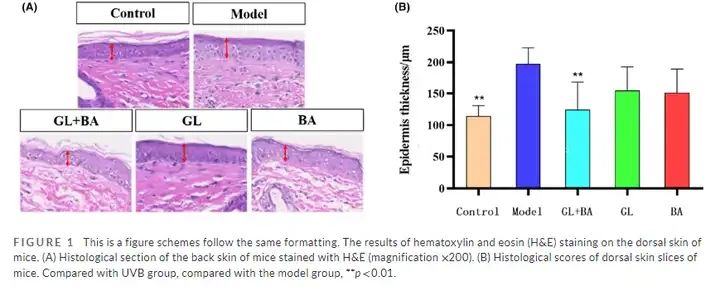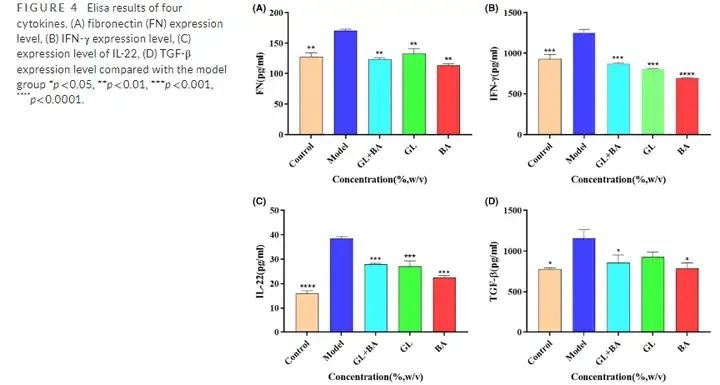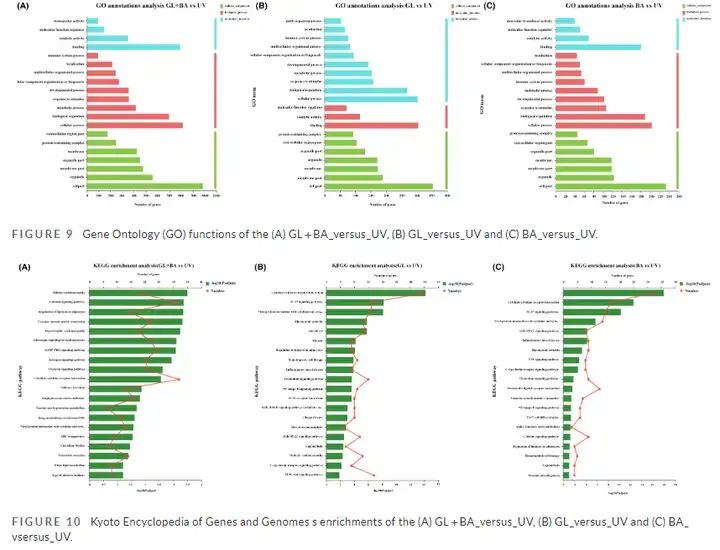Bakuchiol and Glabridin for skin are both popular ingredients in recent years. What will happen when these two join hands?
A recent research paper published by JCD Cosmetic Dermatologynurna tells us that the combination of Glabridin and Bakuchiol can improve UVB-induced skin damage.
The idea of the study was as follows: through in vitro animal tests, the effects of single Glabridin, Bakuchiol and the combination of the two on the inflammatory factors TNF-α and IL-1β were investigated respectively; then in the tissue dimension, the effects of the above components and combinations on fibronectin (FN), interferon-gamma (IFN- γ), IL- 22, and TGF- β were continued to be investigated, and the effects on skin enzyme levels were also investigated. and the effects on skin enzyme levels were also examined. Based on these results, transcriptomics and metabolomics analyses were combined to reveal the potential mechanism of action.
1. Bakuchiol and Glabridin for skin inhibits epidermal hyperplasia
After UVB irradiation, the skin becomes inflamed and undergoes pathological changes, of which epidermal hyperplasia is an important indicator. It can be seen that when Glabridin is applied topically in combination with Bakuchiol, epidermal hyperplasia caused by dermatitis can be significantly inhibited.

2. Bakuchiol and Glabridin for skin reduces inflammatory cell infiltration
Mast cell infiltration occurs in the dorsal skin tissue of mice under UVB irradiation. When Glabridin+Bakuchiol was applied topically, the degree of mast cell infiltration was significantly lower than that in the model group. Although the above two components alone also showed significant inhibitory effects, the best results were obtained when they were used in combination.

3. Bakuchiol and Glabridin for skin inhibits inflammatory factors
Two hallmark inflammatory markers, IL-1β and TNF-α, were measured in the experiments.Compared with the model group, Glabridin+Bakuchiol resulted in lower expression of IL-1β in skin tissues, but the inhibitory ability of Bakuchiol was stronger; whereas for TNF-α, a marker, the combination of Glabridin+Bakuchiol had the most for the TNF-α marker, the combination of Glabridin+Bakuchiol had the most obvious effect.

4. Bakuchiol and Glabridin for skin Regulates the Levels of IFN- γ, FN, IL-22 and TGF-β
After irradiation, the levels of FN, IFN-γ, interleukin 22 (IL- 22), and TGF-β were elevated in the skin tissues of mice compared to controls. Like IL-22, it is common in psoriasis skin lesions. When its level is elevated, it leads to alterations in cytokines and inflammatory mediators, which play a role in chemotaxis of inflammatory cells, pro-proliferation of keratinocytes, and inhibition of keratinocyte differentiation. Compared with the model group, both single and combined components decreased the levels of FN, IFN-γ, and IL-22 in skin tissues. Among them, the level of each factor in the skin tissue of mice in the Bakuchiol group alone decreased most significantly.
 5. Bakuchiol and Glabridin for skin Regulates SOD, MDA and HYP
5. Bakuchiol and Glabridin for skin Regulates SOD, MDA and HYP
UVB radiation caused a significant increase in MDA levels and a significant decrease in SOD and HYP levels in mouse skin tissues. The results showed that Glabridin+Bakuchiol was able to increase the levels of SOD and HYP, and decrease the concentration of MDA.The strongest effect of Bakuchiol was in the regulation of MDA, while the best effect in the regulation of HYP was achieved by combining the two components.
 6. Analysis of differentially expressed genes and gene expression levels of Bakuchiol and Glabridin for skin
6. Analysis of differentially expressed genes and gene expression levels of Bakuchiol and Glabridin for skin
Based on the above results, the researchers further investigated the underlying mechanisms. 3292 genes were significantly down-regulated and 2706 genes were significantly up-regulated in the Glabridin+ Bakuchiol group. Through GO and KEGG enrichment, it was found that the combination of Glabridin and Bakuchiol could not only reduce and inhibit UVB damage to skin cells through cytokine receptor interactions, but also through calcium signaling pathway and IL-17 pathway to achieve the above effects. Finally, metabolomic analysis revealed common differential metabolites between the treatment and model groups, and between the model and control groups, including four pathways, including (-)mentholic acid, spatuline, protoporphyrinogen IX, and glucuronide.

Glabridin has antioxidant whitening and anti-inflammatory in one hand, and Bakuchiol is a classic ingredient for anti-aging, anti-inflammatory and whitening. This study puts these two stars together and also finds new applications for them in the field of anti-light damage. Bakuchiol and Glabridin for skin is a good combination.
Bakuchiol is called plant retinol, it is proved to function the same way as retinol, stimulating collagen production to smooth existing wrinkles and prevent them.
But unlike retinol, bakuchiol does NOT cause irritation, dryness, flaking.
Bakuchiol is stable, can be used during the day.
Bakuchiol soothes skin, relieves allergy; it allows retinol to exert itself and improves the skin’s tolerance to retinol.
Plamed Bakuchiol is lighter in color and odor.
Glabridin is well known as “whitening gold”, it has a very long history in skin whitening and anti-oxidation.
Related Reading
- Canadian customers praised Plamed bakuchiol for its excellent smell and color
- Australian Customer Needs Bakuchiol with Lighter Color
- Bakuchiol: Gentle Plant Retinol for Anti-aging
- Plamed Bakuchiol Benefits for Skin, Also with Good Test Results
- Glabridin Powder Skin Benefits in Cosmetics
- Oman Customer feedback on PCR Glabridin: very effective for lightening, radiance after 10-day use







